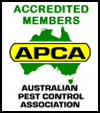Week 1
Week 1 - Day 4 - Pesticide Formulations
ESSENTIAL READING BEFORE COMMENCEMENT OF COURSE:
Urban
Pest Management in Australia: 2004
Edition, UNSW Press, Sydney
by
J Gerozisis and P Hadlington
- Chapter 9 - Pages 68 to 73.
Chapter 9 – Insecticides – Formulations & Applications - insecticide formulations - active constituent - diluent - solvent - attractant - surfacant - synergist - types of formulations - oil concentrates - emulsifiable concentrates - wettable powders - suspension concentrates - micro-encapsulated concentrate - dusts - aerosols - pressure pack aerosols - high pressure, liquid carbon dioxide propelled - other formulations - insecticidal lacquer - smoke generators - baits - granules - ULV (ultra low volume) formulations - impregnated resin strips - choice of formulations - pests to be controlled - convenience of use - application equipment available - pest habits and habitats - price - hazard minimisation - regulatory obligations
Formulations
Many chemicals exist for the control of pests. Often,
these chemicals can be obtained in various formulations eg.
wettable powder, emulsion concentrate, dusts, mist or fog. These
forms are not interchangeable and each type of chemical is
used for a particular purpose.
liquid concentrates
emulsifiable concentrates
This is a solution combining an insecticidal active ingredient (measured in
mls/Iitre or grams/litre), a solvent and emulsifying agents. The emulsifiers
make it possible to mix the concentrate with water to form an emulsion spray. This
type of formulation is not recommended for use on porous surfaces when it is
required to leave an active residual deposit.
Suspension concentrates
A suspension concentrate is a formulation, which has the advantages of both
an emulsifiable concentrate and a wettable powder. More precisely it
is a water-based, particulate suspension, which contains no solvent. The
microscopic particles of insecticide remain on the treated surface for easy
pick-up by the insects and the lack of solvent means that there are no staining
or odour problems.
wettable powders
This is a solid powder formulation with an insecticide component (often a
very high proportion of the total weight and measured in grams/kilogram) and
a special dispersing agent that enables it to be mixed with water forming an
insecticidal suspension. Wettable powders most often use organophosphates,
carbamates and synthetic pyrethroids as their active ingredients. They
are ideal for use on porous surfaces where the water soaks in leaving a fine
film of insecticide powder on top.
Fumigants
Fumigants encompass a wide range of diverse chemical materials. The fumigation
process entails introducing the fumigant material into an airtight space
containing the material to be treated. The fumigant gas kills all stages
of the insect life cycle when sufficient amounts are used. Some fumigants
are stable at ordinary atmospheric temperatures while others eg. methyl bromide,
must be held under pressure in cylinders. Various kinds of fumigation
eg. stack or ship, exist and personnel must have a fumigator's licence in
order to carry out such treatments.
Aerosols
There is a wide variety of active ingredients viz. insecticides, molluscicides,
disinfectants and deodorisers. They come in two varieties: push button
and total release. Insecticide aerosols are of two types - non-residual
space sprays and residual surface sprays. The use of residual aerosols
as an alternative to conventional insecticidal sprays or dusts should be
avoided.
rodenticide baits
cockroach baits
other pest baits
Baits are formulations of an insecticide or rodenticide combined with a palatable
food source. Water baits are used for rodent control in dry areas and
are made by combining a water bait concentrate with the required amount of
water. The active ingredient is kept to the minimum effective amount. The
maximum amount practical depends upon the palatability of the active ingredient
and the susceptibility of the target species.
Useful website links:
Pesticides Labels |
